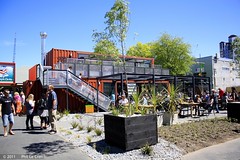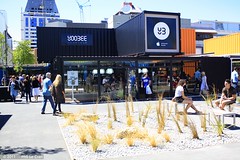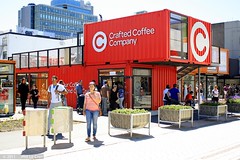
Search
Images for Christchurch CBD; more images...
BeckerFraserPhotos October 2011 photograph 383
Images, UC QuakeStudies
The ground floor of the Central Library on Gloucester Street. Books have fallen off the shelves and are in piles in the aisles.
Central City Tour, 4 April 2011 - Photograph 16
Images, UC QuakeStudies
A spray-painted message on a wall of Englefield Lodge reads "We will try to save this house." Wooden bracing supports the wall. The photographer comments, "A bike ride around the CBD. Englefield, Christchurch's oldest house in Fitzgerald Ave".
What Light Through Yonder Window Breaks?
Images, UC QuakeStudies
Broken stained glass in a window of the ChristChurch Cathedral. The photographer comments, "I only managed to get one picture of the badly earthquake damaged Christchurch Cathedral and I did not want to get the buttresses holding it up like some Medieval siege engine, so I thought this one was perfect. Looking through the window notice that the adjacent wall has gone and the blue windows belong to an office block across the road".
BeckerFraserPhotos December 2011 photograph 0150
Images, UC QuakeStudies
Photograph captioned by BeckerFraserPhotos, "The demolition site of the Copthorne Durham Street with the Casino behind".
The Week in Review- week ending 11 March 2011
Audio, Radio New Zealand
A review of the week's news including: national earthquake memorial service announced, former defence chief to be new Governor General, Reserve Bank slashes official cash rate, Christchurch businesses say OCR cut alone won't save them, mounting concern over Christchurch World Cup prospects, government says 10,000 Christchurch homes will be demolished, alarm over possibility of mass demolition in CBD, international crews head home, petrol prices at three year high, Pike River mine receivers take control from police and boulder sold for thousands in aid of Christchurch
Parking in the Red Zone
Images, UC QuakeStudies
A digitally manipulated photograph of the car parking building on the corner of Manchester and Gloucester Streets. The photographer comments, "Whilst on a tour of the Christchurch earthquake red zone we passed this car park, which I always liked due to its American outgoing feel
BeckerFraserPhotos December 2011 photograph 0281
Images, UC QuakeStudies
An aerial photograph the Christchurch Central City. The photograph has been captioned by BeckerFraserPhotos, "The Hotel Grand Chancellor closely surrounded by the Westpac Building and the Holiday Inn".
BeckerFraserPhotos December 2011 photograph 0278
Images, UC QuakeStudies
An aerial photograph of the Christchurch Central City. The photograph has been captioned by BeckerFraserPhotos, "Central city blocks bounded by Colombo Street, Hereford Street, Cashel Street and High Street".
Nisbet, Alistair, 1958-:Satellite to plunge to earth..."People should see …
Images, Alexander Turnbull Library
The title reads 'Satellite to plunge to earth "People should see quite a show." A 'NASA' satellite heads towards New Zealand; someone inside says 'Beep! Beep! Christchurch CBD here we come! Woo-hoo!' Context: A great deal of the CBD (Central Business District) in Christchurch is being demolished, considered to dangerous or too expensive to restore. A defunct 6.5 ton NASA satellite falls to earth this week... 26 pieces, with a combined mass of 500kg will survive the fiery re-entry and hurtle towards us. NASA doesn't have much idea of where it will land so it may demolish some of Christchurch. Quantity: 1 digital cartoon(s).
BeckerFraserPhotos December 2011 photograph 0335
Images, UC QuakeStudies
An aerial photograph captioned by BeckerFraserPhotos, "Colombo Street beginning at the Copthorne on the left and ending just past the Christchurch Cathedral".
BeckerFraserPhotos December 2011 photograph 2013
Images, UC QuakeStudies
A photograph captioned by BeckerFraserPhotos, "A view from Worcester Street. A gap has been left by the demolition of the Press building, allowing a view of the Copthorne Christchurch Central Hotel".
Steel Structures Damage from the Christchurch Earthquake Series of 2010 an…
Research papers, The University of Auckland Library
This paper presents preliminary field observations on the performance of selected steel structures in Christchurch during the earthquake series of 2010 to 2011. This comprises 6 damaging earthquakes, on 4 September and 26 December 2010, February 22, June 6 and two on June 13, 2011. Most notable of these was the 4 September event, at Ms7.1 and MM7 (MM as observed in the Christchurch CBD) and most intense was the 22 February event at Ms6.3 and MM9-10 within the CBD. Focus is on performance of concentrically braced frames, eccentrically braced frames, moment resisting frames and industrial storage racks. With a few notable exceptions, steel structures performed well during this earthquake series, to the extent that inelastic deformations were less than what would have been expected given the severity of the recorded strong motions. Some hypotheses are formulated to explain this satisfactory performance. http://db.nzsee.org.nz/SpecialIssue/44%284%290297.pdf
BeckerFraserPhotos September 2011 photograph 570
Images, UC QuakeStudies
Photograph captioned by BeckerFraserPhotos, "Looking from Gloucester Street across the demolition site of the Coachman and Canterbury Times (Christchurch Star?) buildings with Heritage Hotel on the left and Novotel in the centre".
BeckerFraserPhotos September 2011 photograph 569
Images, UC QuakeStudies
Photograph captioned by BeckerFraserPhotos, "Looking from Gloucester Street across the demolition site of the Coachman and Canterbury Times (Christchurch Star?) buildings with Heritage Hotel on the left and Novotel in the centre".
BeckerFraserPhotos September 2011 photograph 574
Images, UC QuakeStudies
Photograph captioned by BeckerFraserPhotos, "Looking from Gloucester Street across the demolition site of the Coachman and Canterbury Times (Christchurch Star?) buildings with Heritage Hotel on the left and Novotel in the centre".
Open Plan Living and Good Indoor/Outdoor Flow
Images, UC QuakeStudies
A brick wall has fallen from this house, exposing the rooms within and leaving a pile of rubble in front. The ceiling has slumped and is held up with jacks. The photographer comments, "This was probably the result of the shallower February Christchurch earthquake rather than the bigger September one".
BeckerFraserPhotos December 2011 photograph 0282
Images, UC QuakeStudies
An aerial photograph of the IRD Building in the Christchurch central city and the surrounding area. The photograph has been captioned by BeckerFraserPhotos, "There are many empty sites in this part of the CBD. The street running up the photograph from the left to the right is Cashel Street. The empty site left of centre with the trees is where St John's Church has been demolished. To the left of the IRD building, is the site of the CTV Building".
Mark Lincoln Photograph 098
Images, UC QuakeStudies
A view down Manchester Street, looking south. The road is noticably buckled, and rubble from damaged buildings can be seen beyond the cordon fence. The photographer comments, "Today I ... went for a walk along the cordon to the north of Christchurch CBD which runs about one street back from Bealey Avenue. The soldiers manning the cordon seemed happy for me to take photos but I couldn't see much of the city from the barrier ... what you can see shows there's obviously a lot of damage. The roads are swollen and raised in many place. The once flat CBD will now feature plenty of hills as well as natural traffic calming features".
Seismic Performance of Reinforced Concrete Buildings in the 22 February Ch…
Research papers, University of Canterbury Library
Six months after the 4 September 2010 Mw 7.1 Darfield (Canterbury) earthquake, a Mw 6.2 Christchurch (Lyttelton) aftershock struck Christchurch on the 22 February 2011. This earthquake was centred approximately 10km south-east of the Christchurch CBD at a shallow depth of 5km, resulting in intense seismic shaking within the Christchurch central business district (CBD). Unlike the 4 Sept earthquake when limited-to-moderate damage was observed in engineered reinforced concrete (RC) buildings [35], in the 22 February event a high number of RC Buildings in the Christchurch CBD (16.2 % out of 833) were severely damaged. There were 182 fatalities, 135 of which were the unfortunate consequences of the complete collapse of two mid-rise RC buildings. This paper describes immediate observations of damage to RC buildings in the 22 February 2011 Christchurch earthquake. Some preliminary lessons are highlighted and discussed in light of the observed performance of the RC building stock. Damage statistics and typical damage patterns are presented for various configurations and lateral resisting systems. Data was collated predominantly from first-hand post-earthquake reconnaissance observations by the authors, complemented with detailed assessment of the structural drawings of critical buildings and the observed behaviour. Overall, the 22 February 2011 Mw 6.2 Christchurch earthquake was a particularly severe test for both modern seismically-designed and existing non-ductile RC buildings. The sequence of earthquakes since the 4 Sept 2010, particularly the 22 Feb event has confirmed old lessons and brought to life new critical ones, highlighting some urgent action required to remedy structural deficiencies in both existing and “modern” buildings. Given the major social and economic impact of the earthquakes to a country with strong seismic engineering tradition, no doubt some aspects of the seismic design will be improved based on the lessons from Christchurch. The bar needs to and can be raised, starting with a strong endorsement of new damage-resisting, whilst cost-efficient, technologies as well as the strict enforcement, including financial incentives, of active policies for the seismic retrofit of existing buildings at a national scale.
BeckerFraserPhotos December 2011 photograph 0286
Images, UC QuakeStudies
An aerial photograph of the Christchurch central city. The photograph has been captioned by BeckerFraserPhotos, "Tall buildings of the central city with the Christ Church Cathedral in the middle".
BeckerFraserPhotos December 2011 photograph 0300
Images, UC QuakeStudies
An aerial photograph of the Christchurch city central. The photograph is captioned by BeckerFraserPhotos, "Provincial Council Chambers in the middle, with Brannigans on the lower left, the Central Library lower middle and the Farmers car park on the lower right".
BeckerFraserPhotos December 2011 photograph 0285
Images, UC QuakeStudies
An aerial photograph of the Christchurch Central City. The photograph has been captioned by BeckerFraserPhotos, "Central city blocks bounded by Colombo Street, Hereford Street, Cashel Street and High Streets".
BeckerFraserPhotos December 2011 photograph 0272
Images, UC QuakeStudies
An aerial photograph of the Christchurch central city. The photograph has been captioned by BeckerFraserPhotos, "Central city blocks bounded by Colombo Street, Hereford Street, Cashel Street and High Streets".
BeckerFraserPhotos December 2011 photograph 0293
Images, UC QuakeStudies
An aerial photograph of the Christchurch central city near Cashel and High Streets. The photograph has been captioned by BeckerFraserPhotos, "The dense collection of buildings surrounding the Hotel Grand Chancellor with the two cranes being used for the demolition. What little of the street is visible running horizontally across the photograph is Hereford Street".
The Cathedral has Developed a Bald Spot
Images, UC QuakeStudies
The Cathedral of the Blessed Sacrament after the dome was removed. Large cracks are visible in the walls and in the dome's supporting structure, and the facade is supported by haybales and shipping containers. The photographer comments, "The main dome of the Cathedral of the Blessed Sacrament became unsafe after the February Christchurch earthquake - workmen have slowly been dismantling it. Now we are just left with the cracked and twisted walls that supported the beautiful dome".
Central City Tour, 4 April 2011 - Photograph 15
Images, UC QuakeStudies
Damage to Englefield Lodge on Fitzgerald Avenue. A pile of bricks lies in front of the house, windows are boarded up, and wooden bracing is propping up the walls. A spray-painted message on a wall reads "We will try to save this house." The photographer comments, "A bike ride around the CBD. Englefield, Christchurch's oldest house, in Fitzgerald Ave".
Building and bridge pounding damage observed in 2011 Christchurch earthqua…
Research papers, University of Canterbury Library
This paper describes pounding damage sustained by buildings and bridges in the February 2011 Christchurch earthquake. Approximately 6% of buildings in Christchurch CBD were observed to have suffered some form of serious pounding damage. Almost all of this pounding damage occurred in masonry buildings, further highlighting their vulnerability to this phenomenon. Modern buildings were found to be vulnerable to pounding damage where overly stiff and strong ‘flashing’ components were installed in existing building separations. Soil variability is identified as a key aspect that amplifies the relative movement of buildings, and hence increases the likelihood of pounding damage. Pounding damage in bridges was found to be relatively minor and infrequent in the Christchurch earthquake.
Geotechnical Aspects of the 22 February 2011 Christchurch earthquake
Research papers, University of Canterbury Library
The 22 February 2011, Mw6.2-6.3 Christchurch earthquake is the most costly earthquake to affect New Zealand, causing 181 fatalities and severely damaging thousands of residential and commercial buildings, and most of the city lifelines and infrastructure. This manuscript presents an overview of observed geotechnical aspects of this earthquake as well as some of the completed and on-going research investigations. A unique aspect, which is particularly emphasized, is the severity and spatial extent of liquefaction occurring in native soils. Overall, both the spatial extent and severity of liquefaction in the city was greater than in the preceding 4th September 2010 Darfield earthquake, including numerous areas that liquefied in both events. Liquefaction and lateral spreading, variable over both large and short spatial scales, affected commercial structures in the Central Business District (CBD) in a variety of ways including: total and differential settlements and tilting; punching settlements of structures with shallow foundations; differential movements of components of complex structures; and interaction of adjacent structures via common foundation soils. Liquefaction was most severe in residential areas located to the east of the CBD as a result of stronger ground shaking due to the proximity to the causative fault, a high water table approximately 1m from the surface, and soils with composition and states of high susceptibility and potential for liquefaction. Total and differential settlements, and lateral movements, due to liquefaction and lateral spreading is estimated to have severely compromised 15,000 residential structures, the majority of which otherwise sustained only minor to moderate damage directly due to inertial loading from ground shaking. Liquefaction also had a profound effect on lifelines and other infrastructure, particularly bridge structures, and underground services. Minor damage was also observed at flood stop banks to the north of the city, which were more severely impacted in the 4th September 2010 Darfield earthquake. Due to the large high-frequency ground motion in the Port hills numerous rock falls and landslides also occurred, resulting in several fatalities and rendering some residential areas uninhabitable.
BeckerFraserPhotos December 2011 photograph 0320
Images, UC QuakeStudies
An aerial photograph of the Christchurch central city. The photograph has been captioned by BeckerFraserPhotos, "This photograph shows nearly all of the CBD. The two streets which are prominent in this photograph are Manchester Street on the left and Colombo Street on the right of the photograph. This photograph is from the north, looking towards the southern part of the city. Cathedral Square is about half way up, towards the right. It shows the extent of demolition that has happened already close to the river and near the Manchester/Gloucester Street intersection where there is a lot of bare land surrounding Radio Network House".
The Week in Review - week ending 12 August 2011
Audio, Radio New Zealand
The Week In Review for week ending 12 August 2011... featuring a new rebuild plan for Christchurch's earthquake ravaged CBD, problems at the Waikato-Tainui Tribal Parliament, a pricing fiasco surrounding the Adidas All Blacks Rugby World Cup jersey, the Mana party confirms it will contest all seven Maori seats and some general seats in November's general election, the renaming of Mt Cook's South Ridge to The Hillary Ridge and the White Mouse passes away.



